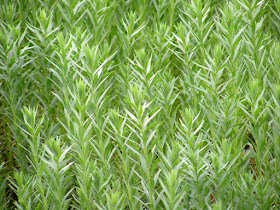Winter flax (Fr. lin d'hiver) crops are more numerous here every year. They provide a way of diversifying on arable farms required to meet the EU 'three crop rule' (simply alternating the same two crops is not allowed).
A flax crop near Chaumussay in early April.
Cultivated flax is an annual which can grow to a metre tall and has a
root system that can go down a metre. Each of the plants' blue flowers will
produce a capsule with ten seeds.
Adapted to no-till cultivation so long as there is deep well structured soil, the crop reduces the risk of erosion by covering the soil from autumn onwards and limits the impact of drought in late spring. Not much eats flax in the field and it allows a break from crops such as canola or cereals. This means that weeds such as geranium and wild mustards can be kept in check as part of the crop rotation while reducing herbicide usage. It is not sown in sandy soil or other soils which dry out too quickly, and does best if following a cereal crop such as wheat or barley.
A close up of the young flax plants.
Although at the moment France is not a big producer of flax seed (aka linseed) it is in high demand at present, both for human and animal feed, due to its nutritiousness and being high in omega 3s. It yields slightly more than wheat and has slightly lower costs of production, resulting in a significantly better margin for flax.
A flax crop coming into flower in late April.
The ground is prepared for sowing by spraying with a herbicide initially and here, probably harrowed to break up the surface of the soil. It's important that the crop doesn't have to compete too much too early. The seeds are sown in September in the Touraine. The crop grows steadily from November to April, during which time it may be sprayed in late spring with an insecticide for thrips and a fungicide if necessary. Other herbicides, fungicides and growth inhibitors may be applied depending on the inclination of the farmer and the seasonal conditions, but compared to other common crops flax needs few pesticides and little fertilizer. The Flax crop will flower in May - June and be harvested in July - August.
A closer look at the flax flowers.
Farmers fertilize the field either by spreading muck or dressing with a synthetic nitrogenous fertilizer. Flax doesn't need supplementary phosphate or potassium, but it can suffer from zinc deficiency when growing in wet calcareous soil. Control of thrips is important because they can prevent the plants from flowering. Apparently the test to check if the crop has an infestation is to brush a sweaty palm over the tops of the flax plants in several places. If you get more than three or four thrips stuck to your hand each time, that is sufficient to indicate you need to spray. To prevent fungal diseases it is recommended that there is a six year gap between flax crops in a field.
A mature flax crop in the Claise valley between Chaumussay and Preuilly in July.
The harvest must be done in hot dry conditions. After the seeds are harvested the straw is sometimes ploughed in to improve the soil, but usually it is also taken off as it takes a long time to break down. It has value as biofuel, insulation, animal bedding or mulch, unless too contaminated by weeds.
Flax seeds just about ready to harvest.
Flax has also become popular as a green manure or cover crop in vegetable gardens here. In that case you are advised to prepare the soil by hoeing and weeding carefully, then sowing the seed in March-April. It is being suggested as a companion plant for potatoes, as there is a widespread belief in France that it repels Colorado Beetle (Fr. doryphores). Unfortunately, like most companion planting, this idea has been scientifically tested and in a number of cases more Colorado Beetles were recorded on the potatoes interplanted with flax than on the control crop of potatoes.
A box of flax seeds for use in the vegetable garden and some for human consumption.
The garden seeds were grown in France, but the eating seeds come from outside the EU (most likely Canada, since they are the largest producer of linseed worldwide).
Flax that is grown for the fibre is sown in the spring and the plants must be pulled at harvest, not cut, and left to lay in the field for two months to rett. I've seen this being done in the north of France, but not here in central France. Linen cloth has been produced in France since the 9th century and France is still by far the biggest producer worldwide of linen fibre.








3 comments:
Flax was once a big crop in the Sarthe area and many of the small round buildings I used to take for pigeonniers are actually for drying hemp. I think there's a four a chanvre at La Corroirie du Liget in your neck of the woods.
Hemp and flax are two different crops, although they produce an almost identical bast fibre and once harvested are treated in a similar way. Hemp (Fr. chanvre) is easier to grow than flax. I suspect that in Sarthe they may have grown both. Here in the Touraine is not a traditional flax growing area, but hemp was certainly grown from at least medieval times. We have a former hemp mill in Preuilly and you are quite right there is hemp oven at La Corroirie.
I learn something new just about every day on your blog, and some days I learn more than one thing.
Post a Comment